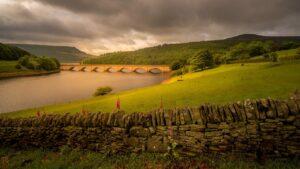CTR Photography
Ladybower Reservoir Derbyshire

Ladybower Reservoir
Ladybower Reservoir is a large Y-shaped, artificial reservoir located in the Upper Derwent Valley, Derbyshire, England. It’s the lowest of three reservoirs in the area.
The River Ashop flows into the reservoir from the west, and the River Derwent flows south, initially through Howden Reservoir, then Derwent Reservoir, and finally through Ladybower Reservoir.
The construction of Ladybower began in 1935 and was completed in 19452. It involved the construction of two huge dams across the River Derwent, creating a 2.5-mile-long reservoir. The reservoir is owned by Severn Trent. The area is now a tourist attraction, with the Fairholmes visitors’ centre located at the northern tip of Ladybower.
One of the interesting features of the reservoir are its giant bell mouth overflows, known locally as plugholes. When water levels are low, these bell mouths are fully exposed.
The reservoir was officially opened by King George VI on 24th September 1945. During the 1990s, the wall was raised and strengthened to reduce the risk of over-topping in a major flood.
Below the dam is a cut-off trench 180 ft deep and 6 ft wide filled with concrete, stretching 500 ft into the hills each side, to stop water leaking around the dam1. The dam wall was built by Richard Baillie and Sons, a Scottish company. The two viaducts, Ashopton and Ladybower, needed to carry the trunk roads over the reservoir, were built by the London firm of Holloways, using a steel frame clad in concrete.
The project was delayed when the Second World War broke out in 1939, making labour and raw materials scarce, but construction was continued due to the strategic importance of maintaining supplies1. King George VI, accompanied by his wife, Queen Elizabeth, formally opened the reservoir on 25 September 1945.
During the 1990s, the wall was raised and strengthened to reduce the risk of over-topping in a major flood. The original dam wall contains 100,000 tons of concrete, over one million tons of earth, and 100,000 tons of clay for the core1. The upstream face is stone-faced.
Interestingly, the construction of the reservoir led to the ‘drowning’ of the villages of Derwent and Ashopton. During dry periods when the reservoir’s water levels drop, the lost village of Derwent reappears. Some locals swore they could hear the church bell ringing out across the waters – although the bell had been removed before the village was drowned.
What was the purpose of building Ladybower Reservoir?
The primary purpose of building the Ladybower Reservoir was to supplement the water needs of the East Midlands. The reservoir was constructed by the Derwent Valley Water Board, which was formed by the Sheffield Water Board, the corporations of Nottingham, Derby, and Leicester, along with several smaller authorities. This collaboration aimed to avoid rivalry by sharing the liquid spoils of the River Derwent.
The construction of the reservoirs was a response to the increasing demand for drinking water due to the population boom in the East Midlands during the Industrial Revolution. The valleys carved out by the River Derwent in the Derbyshire hills offered an ideal solution for this pressing problem, as they seemed to be naturally designed for conversion into reservoirs.
Ladybower, along with the other two reservoirs in the Upper Derwent Valley, Howden and Derwent, played a crucial role in maintaining water supplies, especially during times of scarcity. The reservoirs continue to serve their purpose, providing a reliable source of water for the region